lock YAMAHA KODIAK 450 2022 User Guide
[x] Cancel search | Manufacturer: YAMAHA, Model Year: 2022, Model line: KODIAK 450, Model: YAMAHA KODIAK 450 2022Pages: 170, PDF Size: 5.18 MB
Page 39 of 170
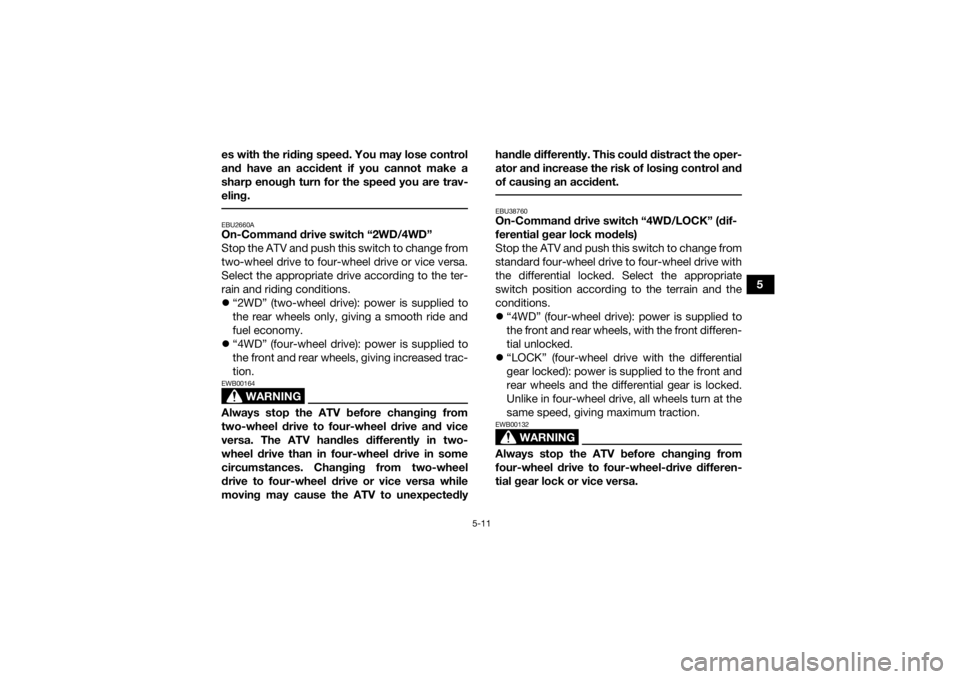
5-11
5
es with the riding speed. You may lose control
and have an accident if you cannot make a
sharp enough turn for the speed you are trav-
eling.
EBU2660AOn-Command drive switch “2WD/4WD”
Stop the ATV and push this switch to change from
two-wheel drive to four-wheel drive or vice versa.
Select the appropriate drive according to the ter-
rain and riding conditions.
“2WD” (two-wheel drive): power is supplied to
the rear wheels only, giving a smooth ride and
fuel economy.
“4WD” (four-wheel drive): power is supplied to
the front and rear wheels, giving increased trac-
tion.
WARNING
EWB00164Always stop the ATV before changing from
two-wheel drive to four-wheel drive and vice
versa. The ATV handles differently in two-
wheel drive than in four-wheel drive in some
circumstances. Changing from two-wheel
drive to four-wheel drive or vice versa while
moving may cause the ATV to unexpectedly handle differently. This could distract the oper-
ator and increase the risk of losing control and
of causing an accident.
EBU38760On-Command drive switch “4WD/LOCK” (dif-
ferential gear lock models)
Stop the ATV and push this switch to change from
standard four-wheel drive to four-wheel drive with
the differential locked. Select the appropriate
switch position according to the terrain and the
conditions.
“4WD” (four-wheel drive): power is supplied to
the front and rear wheels, with the front differen-
tial unlocked.
“LOCK” (four-wheel drive with the differential
gear locked): power is supplied to the front and
rear wheels and the differential gear is locked.
Unlike in four-wheel drive, all wheels turn at the
same speed, giving maximum traction.
WARNING
EWB00132Always stop the ATV before changing from
four-wheel drive to four-wheel-drive differen-
tial gear lock or vice versa.
UBHT60E0.book Page 11 Wednesday, August 4, 2021 8:09 AM
Page 40 of 170
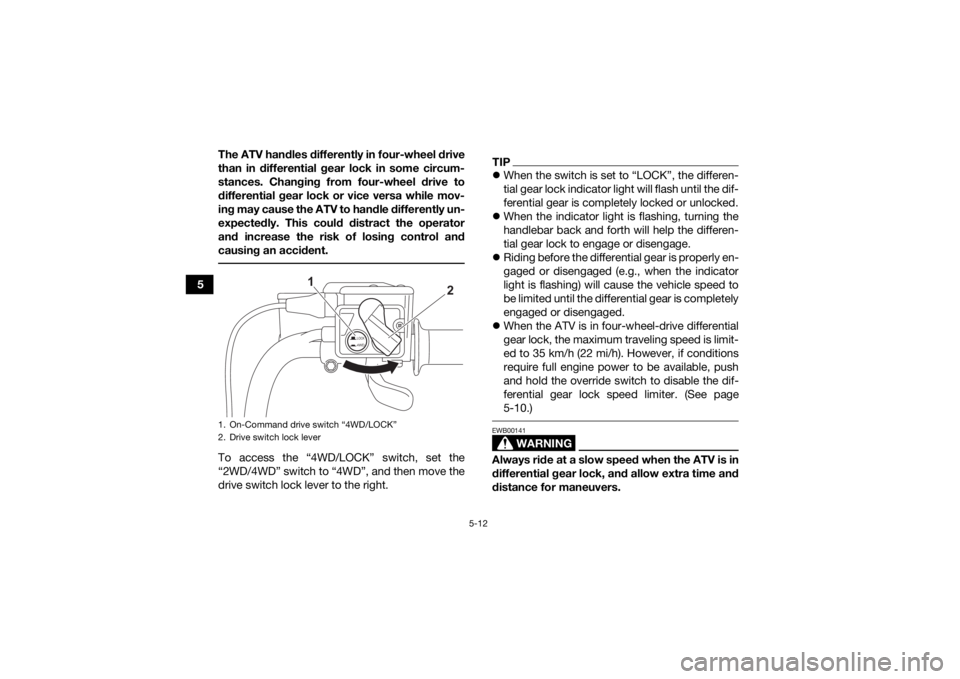
5-12
5The ATV handles differently in four-wheel drive
than in differential gear lock in some circum-
stances. Changing from four-wheel drive to
differential gear lock or vice versa while mov-
ing may cause the ATV to handle differently un-
expectedly. This could distract the operator
and increase the risk of losing control and
causing an accident.
To access the “4WD/LOCK” switch, set the
“2WD/4WD” switch to “4WD”, and then move the
drive switch lock lever to the right.
TIP
When the switch is set to “LOCK”, the differen-
tial gear lock indicator light will flash until the dif-
ferential gear is completely locked or unlocked.
When the indicator light is flashing, turning the
handlebar back and forth will help the differen-
tial gear lock to engage or disengage.
Riding before the differential gear is properly en-
gaged or disengaged (e.g., when the indicator
light is flashing) will cause the vehicle speed to
be limited until the differential gear is completely
engaged or disengaged.
When the ATV is in four-wheel-drive differential
gear lock, the maximum traveling speed is limit-
ed to 35 km/h (22 mi/h). However, if conditions
require full engine power to be available, push
and hold the override switch to disable the dif-
ferential gear lock speed limiter. (See page
5-10.)
WARNING
EWB00141Always ride at a slow speed when the ATV is in
differential gear lock, and allow extra time and
distance for maneuvers.
1. On-Command drive switch “4WD/LOCK”
2. Drive switch lock lever
LOCK4WD
1
2
UBHT60E0.book Page 12 Wednesday, August 4, 2021 8:09 AM
Page 41 of 170

5-13
5
All wheels turn at the same speed when the dif-
ferential gear is locked, so it takes more effort
to turn the ATV. The effort needed to turn in-
creases with the riding speed. You may lose
control and have an accident if you cannot
make a sharp enough turn for the speed you
are traveling.
EBU18286Throttle leverPush the throttle lever to increase engine speed.
Spring tension returns the lever to the rest position
when released. Always check that the throttle le-
ver returns normally before starting the engine.
EBU18325Speed limiterThe speed limiter keeps the throttle from fully
opening, even when the throttle lever is pushed to
the maximum.
Adjusting the speed limiter1. Loosen the locknut.
2. To increase the maximum engine power
available and the maximum speed of the ATV,
turn the adjusting screw in direction (a). To
decrease the maximum engine power avail-
able and the maximum speed of the ATV, turn
1. Throttle lever
2WD
4WD
1
1. Locknut
2. Adjusting screw
3. No more than 12 mm (0.47 in)
UBHT60E0.book Page 13 Wednesday, August 4, 2021 8:09 AM
Page 42 of 170
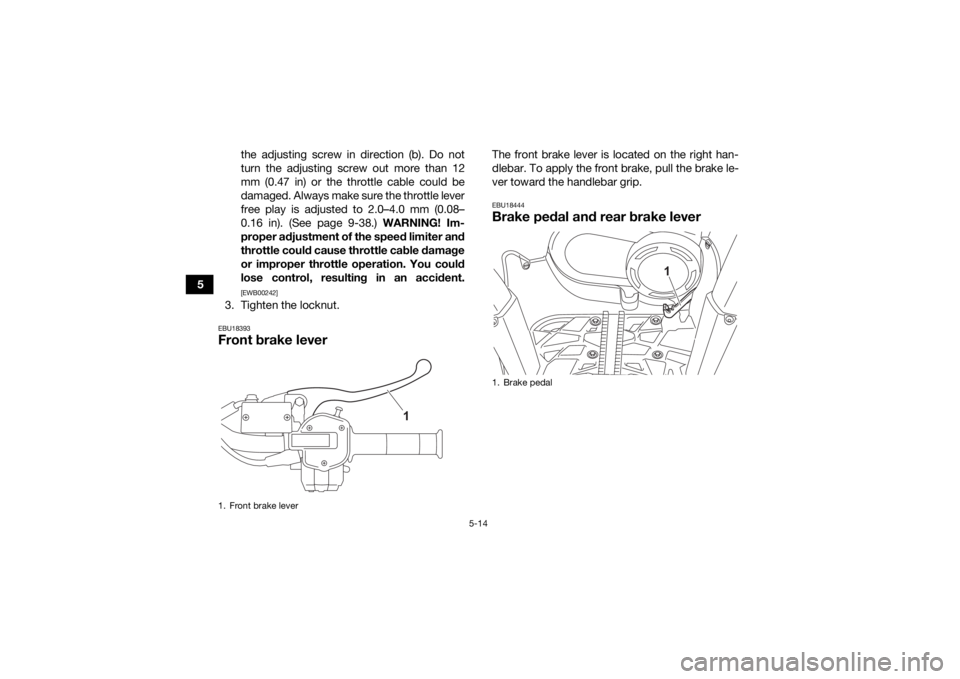
5-14
5the adjusting screw in direction (b). Do not
turn the adjusting screw out more than 12
mm (0.47 in) or the throttle cable could be
damaged. Always make sure the throttle lever
free play is adjusted to 2.0–4.0 mm (0.08–
0.16 in). (See page 9-38.)
WARNING! Im-
proper adjustment of the speed limiter and
throttle could cause throttle cable damage
or improper throttle operation. You could
lose control, resulting in an accident.
[EWB00242]
3. Tighten the locknut.EBU18393Front brake lever
The front brake lever is located on the right han-
dlebar. To apply the front brake, pull the brake le-
ver toward the handlebar grip.EBU18444Brake pedal and rear brake lever
1. Front brake lever
1
1. Brake pedal
1
UBHT60E0.book Page 14 Wednesday, August 4, 2021 8:09 AM
Page 44 of 170
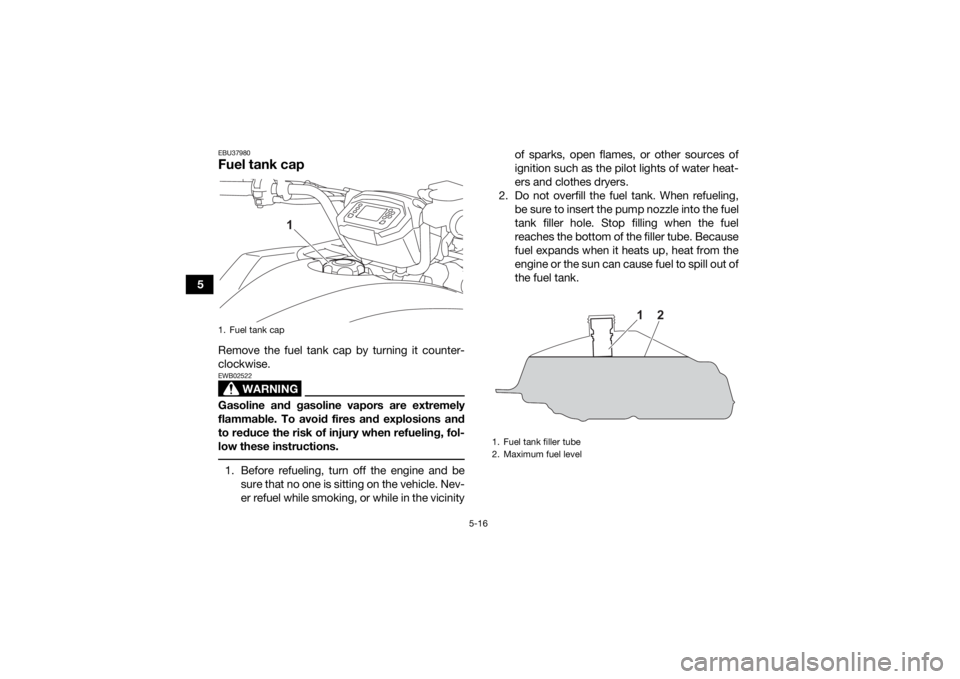
5-16
5
EBU37980Fuel tank capRemove the fuel tank cap by turning it counter-
clockwise.
WARNING
EWB02522Gasoline and gasoline vapors are extremely
flammable. To avoid fires and explosions and
to reduce the risk of injury when refueling, fol-
low these instructions. 1. Before refueling, turn off the engine and besure that no one is sitting on the vehicle. Nev-
er refuel while smoking, or while in the vicinity of sparks, open flames, or other sources of
ignition such as the pilot lights of water heat-
ers and clothes dryers.
2. Do not overfill the fuel tank. When refueling, be sure to insert the pump nozzle into the fuel
tank filler hole. Stop filling when the fuel
reaches the bottom of the filler tube. Because
fuel expands when it heats up, heat from the
engine or the sun can cause fuel to spill out of
the fuel tank.1. Fuel tank cap
1
1. Fuel tank filler tube
2. Maximum fuel level
1
2
UBHT60E0.book Page 16 Wednesday, August 4, 2021 8:09 AM
Page 45 of 170
![YAMAHA KODIAK 450 2022 User Guide 5-17
5
3. Wipe up any spilled fuel immediately.
NOTICE: Immediately wipe off spilled fuel
with a clean, dry, soft cloth, since fuel may
deteriorate painted surfaces or plastic
parts.
[ECB00982]
4. T YAMAHA KODIAK 450 2022 User Guide 5-17
5
3. Wipe up any spilled fuel immediately.
NOTICE: Immediately wipe off spilled fuel
with a clean, dry, soft cloth, since fuel may
deteriorate painted surfaces or plastic
parts.
[ECB00982]
4. T](/img/51/50531/w960_50531-44.png)
5-17
5
3. Wipe up any spilled fuel immediately.
NOTICE: Immediately wipe off spilled fuel
with a clean, dry, soft cloth, since fuel may
deteriorate painted surfaces or plastic
parts.
[ECB00982]
4. Turn the fuel tank cap fully clockwise to make sure it is securely closed.EBU38651FuelMake sure there is sufficient gasoline in the tank
before starting off. Refuel if necessary.
WARNING
EWB02532Gasoline is poisonous and can cause injury or
death. Handle gasoline with care. Never siphon
gasoline by mouth. If you should swallow some
gasoline or inhale a lot of gasoline vapor, or get
some gasoline in your eyes, see your doctor
immediately. If gasoline spills on your skin,
wash with soap and water. If gasoline spills on
your clothing, change your clothes.
TIPConfirm the gasoline pump nozzle has the same
fuel identification mark. Recommended fuel:Regular unleaded gasoline (Gasohol [E10]
acceptable)
Fuel tank capacity: 14 L (3.7 US gal, 3.1 Imp.gal)
Fuel reserve amount: 4.0 L (1.06 US gal, 0.88 Imp.gal)1. EN228 fuel identification mark
1
E5
E10
UBHT60E0.book Page 17 Wednesday, August 4, 2021 8:09 AM
Page 47 of 170
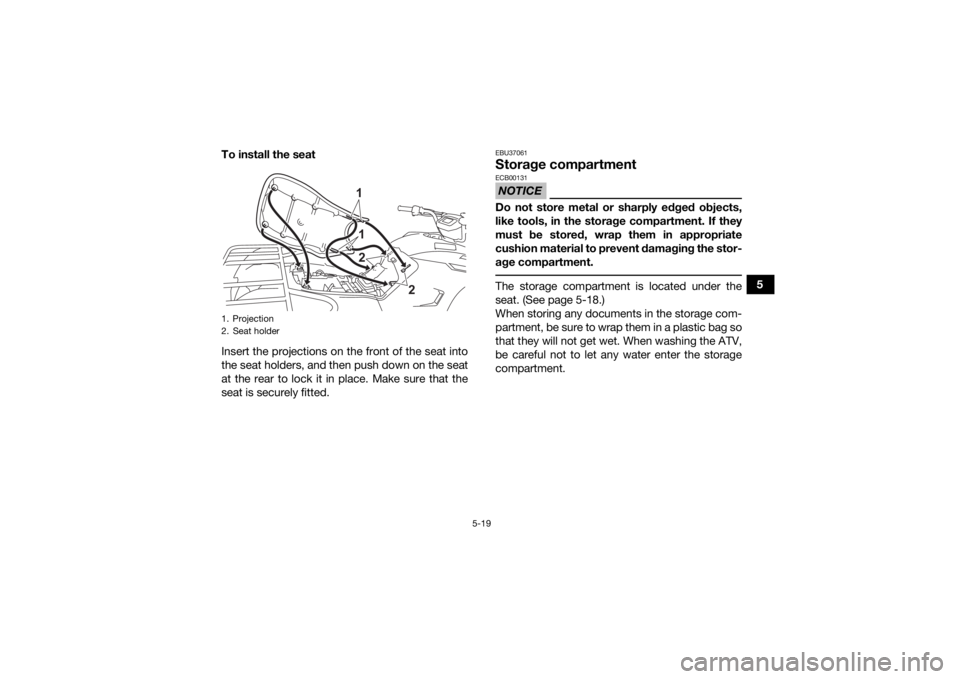
5-19
5
To install the seat
Insert the projections on the front of the seat into
the seat holders, and then push down on the seat
at the rear to lock it in place. Make sure that the
seat is securely fitted.
EBU37061Storage compartmentNOTICEECB00131Do not store metal or sharply edged objects,
like tools, in the storage compartment. If they
must be stored, wrap them in appropriate
cushion material to prevent damaging the stor-
age compartment. The storage compartment is located under the
seat. (See page 5-18.)
When storing any documents in the storage com-
partment, be sure to wrap them in a plastic bag so
that they will not get wet. When washing the ATV,
be careful not to let any water enter the storage
compartment.
1. Projection
2. Seat holder
1
12
2
UBHT60E0.book Page 19 Wednesday, August 4, 2021 8:09 AM
Page 55 of 170

6-2
6
Front brake• Check operation. If soft or spongy, have Yamaha dealer bleed hy-
draulic system.
• Check brake pads for wear, and replace if necessary.
• Check brake fluid level in reservoir, and add specified brake fluid to specified level if necessary.
• Check hydraulic system for leakage. Correct if necessary. 6-3, 9-40, 9-40, 9-42
Rear brake • Check operation, and correct if necessary.
• Lubricate cables if necessary.
• Check lever and pedal free play, and adjust if necessary. 6-3, 9-40, 9-42
Throttle lever • Make sure that operation is smooth. Lubricate cable and lever
housing if necessary.
• Check lever free play, and adjust if necessary. 6-4, 9-38
Control cables • Make sure that operation is smooth. Lubricate if necessary. 9-49
Wheels and tires • Check wheel condition, and replace if damaged.
• Check tire condition and tread depth. Replace if necessary.
• Check air pressure. Correct if necessary. 6-4
Brake pedal • Make sure that operation is smooth. Lubricate pedal pivoting point
if necessary. 9-50
Brake levers • Make sure that operation is smooth. Lubricate lever pivoting points
if necessary. 9-49
Axle boots • Check for cracks or damage, and replace if necessary. 9-47
Chassis fasteners • Make sure that all nuts, bolts and screws are properly tightened. 6-7
Instruments, lights and
switches • Check operation, and correct if necessary. 6-7
Winch • Confirm winch hook and rope are not dangling loose.
• Confirm winch clutch is locked (positively engaged).
5-22
ITEM ROUTINE PAGE
UBHT60E0.book Page 2 Wednesday, August 4, 2021 8:09 AM
Page 65 of 170
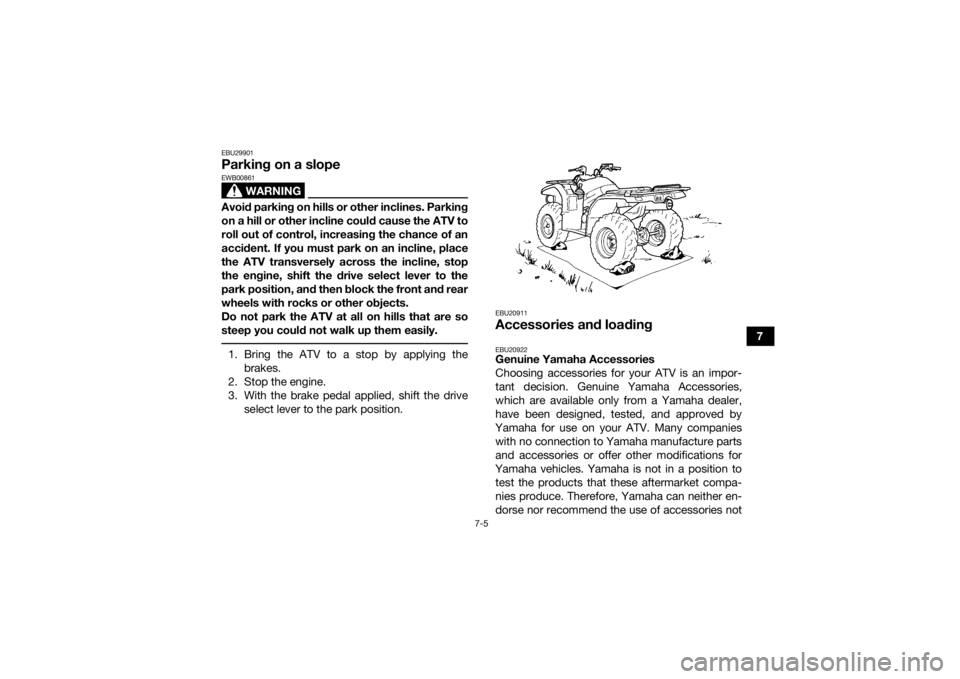
7-5
7
EBU29901Parking on a slope
WARNING
EWB00861Avoid parking on hills or other inclines. Parking
on a hill or other incline could cause the ATV to
roll out of control, increasing the chance of an
accident. If you must park on an incline, place
the ATV transversely across the incline, stop
the engine, shift the drive select lever to the
park position, and then block the front and rear
wheels with rocks or other objects.
Do not park the ATV at all on hills that are so
steep you could not walk up them easily. 1. Bring the ATV to a stop by applying thebrakes.
2. Stop the engine.
3. With the brake pedal applied, shift the drive select lever to the park position.
EBU20911Accessories and loadingEBU20922Genuine Yamaha Accessories
Choosing accessories for your ATV is an impor-
tant decision. Genuine Yamaha Accessories,
which are available only from a Yamaha dealer,
have been designed, tested, and approved by
Yamaha for use on your ATV. Many companies with no connection to Yamaha manufacture parts
and accessories or offer other modifications for
Yamaha vehicles. Yamaha is not in a position to test the products that these aftermarket compa-
nies produce. Therefore, Yamaha can neither en-
dorse nor recommend the use of accessories not
UBHT60E0.book Page 5 Wednesday, August 4, 2021 8:09 AM
Page 82 of 170

8-15
8Do not attempt to climb hills until you have mas-
tered basic maneuvers on flat ground. Always
check the terrain carefully before attempting any
hill. In all cases avoid inclines with slippery or
loose surfaces, or obstacles that might cause you
to lose control.
To climb a hill, you need traction, momentum, and
steady throttle. For more traction and control for
climbing steeper and/or rougher slopes, select
“4WD” or 4WD-LOCK (“DIFF. LOCK”). Travel fast
enough to maintain momentum, but not so fast
that you cannot react to changes in the terrain as
you climb.
It is important when climbing a hill to make sure
that your weight is transferred forward on the ATV.
This can be accomplished by leaning forward and,
on steeper inclines, standing on the footboards
and leaning forward over the handlebars. When-
ever possible, ride straight up hills.
Slow down when you reach the crest of the hill if
you cannot see clearly what is on the other side –
there could be another person, an obstacle, or a
sharp drop-off. Use common sense and remem-
ber that some hills are too steep for you to climb
or descend. If you are climbing a hill and you find that you have
not properly judged your ability to make it to the
top, you should turn the ATV around while you still
have forward motion (provided you have the room
to do so) and go down the hill.
If your ATV has stalled or stopped and you believe
you can continue up the hill, restart carefully to
make sure you do not lift the front wheels which
could cause you to lose control. If you are unable
to continue up the hill, dismount the ATV on the
uphill side. Physically turn the ATV around and
then descend the hill.
If you start to roll backwards, DO NOT apply either
brake abruptly. If you are in “2WD”, apply only the
front brake. When fully stopped, apply the rear
brake as well, and then shift to the park position. If
you are in “4WD”, because all wheels are inter-
connected by the drive train, applying either brake
will brake all wheels, therefore, avoid sudden ap-
plication of either the front or rear brake as the
wheels on the uphill side could come off the
ground. The ATV could easily tip over backwards.
Apply both the front and rear brakes gradually.
When fully stopped, shift to the park position and
dismount the ATV immediately on the uphill side,
or to a side if pointed straight uphill. Turn the ATV
UBHT60E0.book Page 15 Wednesday, August 4, 2021 8:09 AM